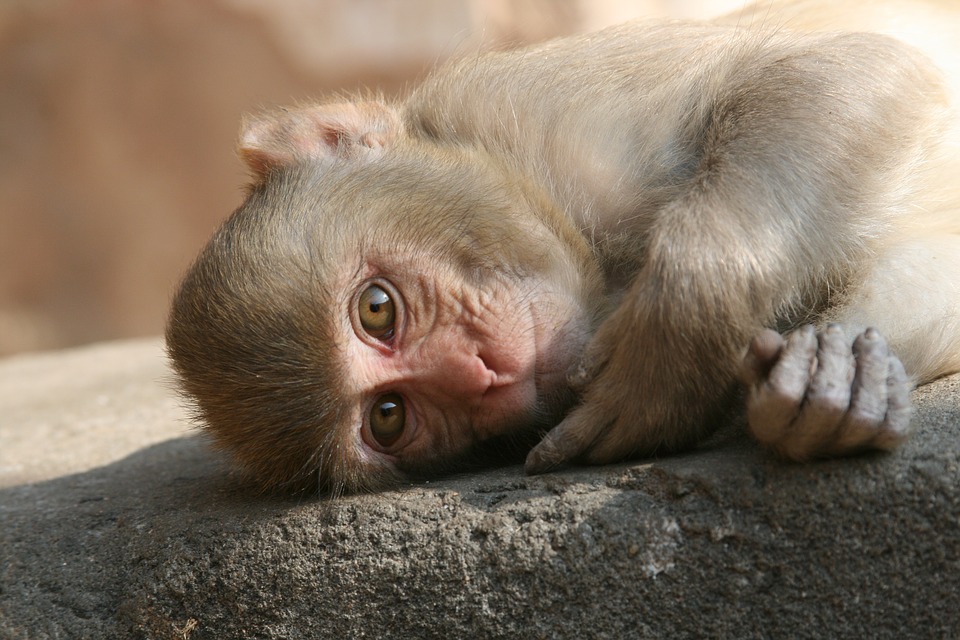In Himachal Pradesh, one can kill monkeys if they are causing harm. But, is that the only solution?
The population of monkeys has fallen, yet, the state has received nod from the environment ministry to declare rhesus macaque monkeys ‘vermin’, opening them up to be hunted and killed


Photo: Pixabay
The central government has declared the Rhesus Macaque species of monkeys as vermin (pest animals) in 10 districts of Himachal Pradesh. After this announcement, farmers or anyone can now kill monkeys to protect their crops or life and property. The only condition is that these monkeys can be only be killed on private properties and not on land belonging to the government, or the forest department.
This primate killing is now allowed in 91 tehsils in 10 districts. However, monkeys are being killed in the state from 2016. These monkeys are allegedly destroying huge portions of crops belonging to farmers. Monkeys are also biting humans. However, is decimating them the only option available to us?
In Himachal Pradesh, the population of monkeys has declined by 33.5 per cent in 2019-20. The state government had sent a report to the central government in February 2019. The report had pointed out that the population of monkeys belonging to the Rhesus Macaque species has substantially increased outside the jungles, causing a large-scale loss to the farmers, and they are also a threat to life and property. Monkeys belonging to the Rhesus Macaque species are protected under Schedule II of the Wildlife (Protection) Act, 1972, but the government, in the exercise of its powers, has declared them as violent animals and allowed them to be hunted for one year.

After a year, the state government sought more time from the Union Ministry of Environment, Forest and Climate Change to kill the monkeys. The central government gave the Himachal Pradesh government an additional one year time, starting from April 23 2020.
Earlier, the wild boars of Uttarakhand were also declared violent. As per a November 2018 notification, the administration was allowed to kill wild boars across several tehsils of 13 districts.
In 2016, to contain the monkey menace, the Himachal Pradesh government had announced a cash prize of Rs 300 for killing a monkey in Shimla city and 38 tehsils of the state. It was later increased to Rs 500. The government is giving a reward of Rs 1,000 for a monkey to be caught and sterilised. When even that failed, large-scale sterilisation of monkeys was planned.
Nine centres were set up in the state. As of March 31, 2020, about 163,375 monkeys were sterilised at these centres, with a total expenditure of about Rs 777 lakh (Rs 7.77 crore). Even after all this, the state government has sought one more year from the central government.
Gauri Moulekhi from Himachal, who has been working on animal rights for a long time, told Gaon Connection over the phone: “The forest ministry is working with the Wild Life Institute of India Dehradun on a drug that will limit the fertility of monkeys. This will also reduce their population. The Delhi government has placed 16,000 monkeys in a sanctuary and arranges to feed them. The monkeys over there behave because they get food.”
She added: “This is a better remedy. The decision to kill monkeys cannot be deemed correct. We are people upholding non-violence. We should extend good treatment to animals. It is written in the Constitution. Then, why did we begin talking about killing? In Himachal Pradesh, the number of monkeys has already decreased by 30 per cent. What is the need to kill them? The government should take appropriate steps to fix the mismanagement that happens in forests. Killing animals is not a solution.”

She informed that the government has wasted crores of rupees on sterilisation of monkeys. Large-scale surgical sterilisation of wild animals was carried out and now a notification has been issued to kill them. Killing animals can’t be the only solution.
In Himachal Pradesh, there were 2.05 lakh monkeys belonging to the Rhesus Macaque species in 2015. As per the 2019-20 report published by the Salim Ali Centre for Ornithology and Natural History, Tamil Nadu, the number of monkeys has come down to 1.36 and they are roaming around in 3,336 groups. The report has been prepared under the supervision of the government and had taken a long time for its survey. The government claims that the number has declined due to sterilisation of monkeys. In 2003-04, the number of monkeys was 3.17 lakh.
According to the survey report, out of the 10 districts, in eight districts, there are more than 37,077 Rhesus Macaque monkeys that have been ordered to kill. The report does not include data from Kangra and Sirmaur districts. If one adds these two districts the figure would increase further. Out of these, the population of monkeys is varied among urban and rural areas.
As per the central government notification, monkeys can be killed only on private land, which may directly mean that most of the monkeys will be killed in rural areas because they are doing a lot of damage to the farmers, but the Shimla Municipal Corporation had also ordered to kill the monkeys. So, monkeys would also be killed in urban areas.
Addressing a function in the year 2019, the Himachal Pradesh Forest Minister, Govind Singh Thakur, said that only 100 monkeys have been killed in the state between 2015 and 2019. This is because the monkeys here are associated with our religion. In 548 gram panchayats, monkeys have damaged more than Rs 184 crore of crops and fruits.

The Himachal Pradesh Kisan Sabha state secretary Sanjay Chauhan has taken the government to task on the entire issue. He said: “The farmers don’t want to and can’t kill the monkeys. The state government takes such steps to absolve itself of any responsibility while the farmers suffer every year. We are constantly demanding from the government to set up fruit-bearing forests so that they go to the jungles. The amount of money that the government is spending on killing of these monekeys, it could have set up many forests. Farmers do not even have weapons to kill monkeys.”
He added: “When the British reigned in the country, they lived in Shimla during summer. They used to export these monkeys to other countries for research purposes. Then the number was controlled to a great extent.”
It is clear that monkey menace is not new to Himachal Pradesh. Ved Prakash, a research scholar in the University of Himachal Pradesh also pointed this out. He said: “The British also knew that there were many religious beliefs surrounding monkeys in India, so they used to take care of the matter silently. There is a major temple of Hanuman Ji in Shimla. It must be understood that the people here do not want to kill the monkeys. The government does not want to do anything on its own and is instead is motivating people to kill monkeys.”
Last year, there were reports that monkeys were being poisoned in Himachal Pradesh. In Solan and Sirmaur district, some farmers had killed monkeys by poisoning them, though the government keps denying it.
Monkeys are ruining crops and even attacking humans. In 2015, nearly 430 cases of monkey bites were treated at the Indira Gandhi Medical College and Hospital in Shimla. In 2016, the cases went up to 626. In 2017, the number stood at 649 while 742 people were bitten by monkeys in 2018. A total of 366 cases of monkey bites were reported until June 2019 last year.
Gaon Connection spoke to Dr Savita, head chief conservator of forests (wildlife) of Himachal Pradesh to understand the entire issue. She said: “Firstly, the media had wrongly reported that monkeys have been allowed to kill on a large scale. As per Section 62 in the Wild Life Protection Act, if any animal is declared vermin, it may be killed. A farmer is allowed to kill the animal if it damages the crops or injuries his child.

She added: “As per Section 11B, you don’t even need to get permission from the government in order to do so. If an animal damages the fields, the DFO (District Forest officer) can allow the animal to be declared vermin after getting permission from the state government. After being declared vermin, humans can kill the animal to save their own life. We demanded the central government to declare them vermin because our farmers were suffering a lot due to these monkeys. In many places, the farmers had given up farming altogether.”
When asked why these monkeys are venturing into the cities, she said: “Tourists come to Himachal Pradesh in large numbers. They eat half of their food stuff and throw away the remaining half. So, the monkeys finding easy food in cities. We don’t want to kill the monkeys anyway. In 2018-19, only five monkeys were killed in the state despite the handsome sum of Rs 500 to kill a monkey. Only those are allowed to kill monkeys who are actually harmed by them.”
Why there was a need to declare the monkey as vermin from the centre when their number is anyhow decreasing? Dr Savita said: “This report had not come up when we had demanded from the central government. We had also worked upon other options. A place to keep the monkeys had also been identified, but later a research revealed that maintaining a monkey would cost at least Rs 1 lakh per annum. We have a huge monkey population, therefore, this option could not be agreed to.

Shimla University student and journalist Ankush believes that the monkeys have caused a lot of damage to the farmers, but for this he deemed the government responsible. He said: “Previously, monkeys were exported to the US, but this export was plugged as soon as the BJP government came to power. Forests have also been chopped off. Man is selling the fruits of the forests. Then what will the monkeys do? Sterilisation also did not help. The scheme of rewards has flopped as well. Now, the government must chart out a national policy on this. Only then will the farmers get rid of this problem. Killing monkeys won’t be of any use.”
There has been a long-standing protest against the declaration of monkeys as vermin. The Dhyan Foundation Trust is also running an online campaign against it. The foundation has also been providing food to the monkeys coming to Jakhoo temple in Shimla for the last four years. The number of monkeys around Hanuman temple is very high.
Poonam Kapoor, who is associated with the foundation, told Gaon Connection: “Our people give fruits, vegetables, chana, etc, to monkeys every day. They do no harm there. Humans are destroying their homes. Where will they go? When they are hungry, their stomachs are empty, only then they harm mankind, ruin the crops. We have also written to the government to withdraw their decision. We are ready to take the responsibility of feeding the monkeys.”

